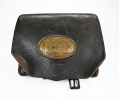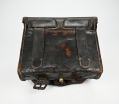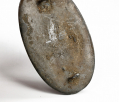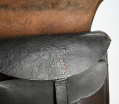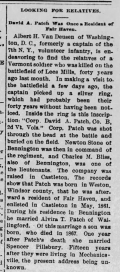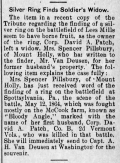site search
online catalog
IDENTIFIED 2nd VERMONT SOLDIER’S CARTRIDGE BOX, KIA AT SPOTTSYLVANIA: HIS RING WAS FOUND THERE FORTY YEARS LATER AND RETURNED TO HIS WIDOW
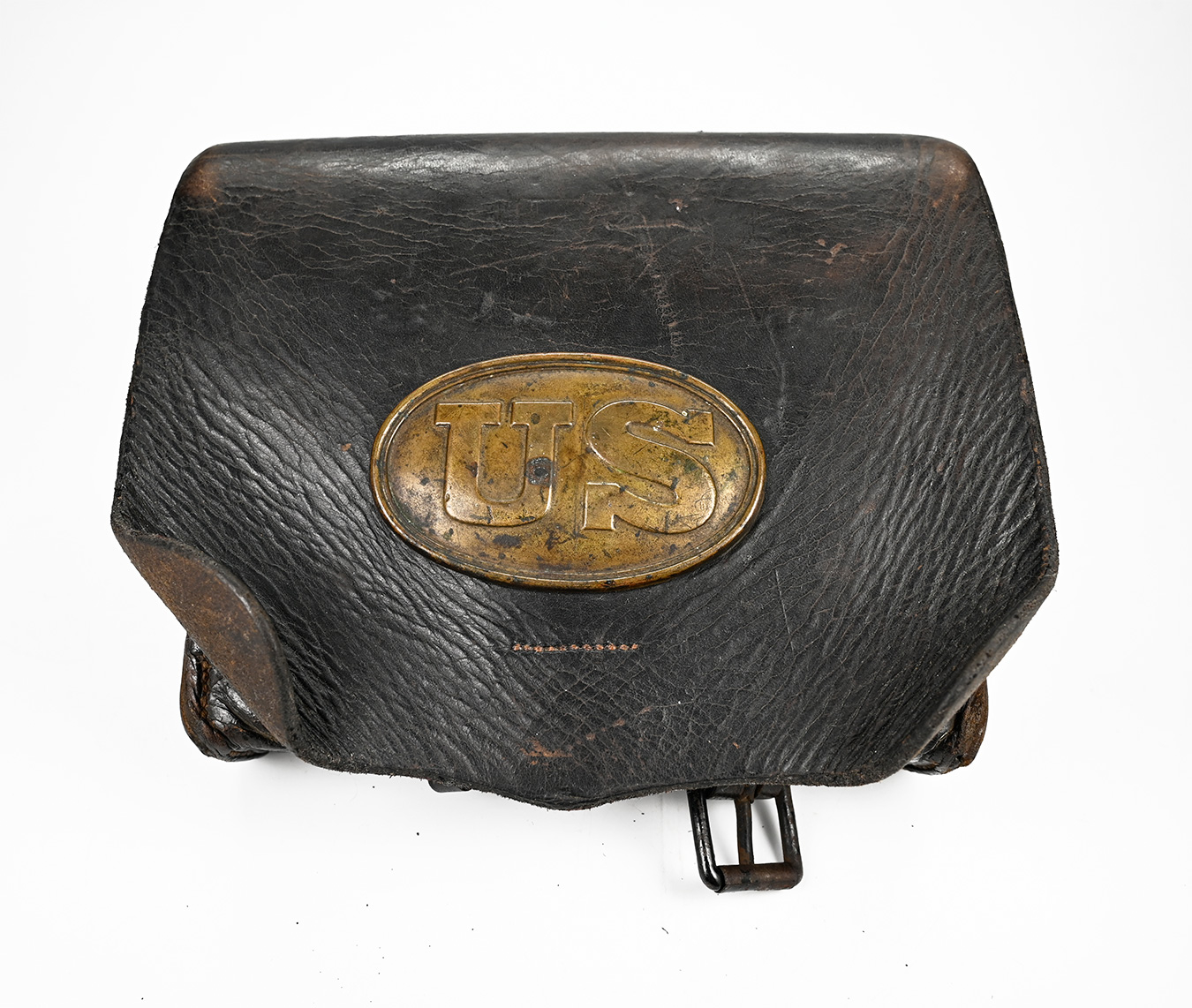
$995.00 SOLD
Quantity Available: None
Item Code: 286-1098
This identified cartridge box was carried by David A. Patch, a corporal in the 2nd Vermont, killed in action at the Bloody Angle at Spottsylvania, May 12, 1864. Patch was buried in an unmarked grave, but his inscribed ring was found on the battlefield forty years later and returned to his widow. His cartridge box may have been returned to the family earlier. A fellow soldier testified on behalf of his widow’s application for a pension that he had both witnessed her husband’s death and brought home some of his possessions. Edward Knox stated that Patch was killed, “by a shot through the head. I saw & well knew his body after his death on the field of battle. I took & brought home to his wife, Elvira T. Patch, whom I well know, his Pocket Book with money in it, & also the likeness of his wife, which I found on his person after his death…” We are also aware that Patch’s identification disk is in a private collection. Just as notable is that he wore an identification ring that was found 40 years later on the battlefield where he died and was returned to his widow in 1904. None of this preserved his identification when bodies were transferred to a national cemetery and he likely rests among the unknowns there.
His cartridge box bears his name in a small ink stencil on the inside of the flap: “David A. Patch.” Only two soldiers of that name served in the Union army. One, a late war recruit from Iowa, is ruled out by the box itself- an early war 1861 pattern made without rivet reinforcements on the belt loops, latch tab, or sling buckles, made and marked by J. Boyd and Sons of Boston. In addition, the box still bears its original Boyd marked cartridge box plate, which uses the company’s pre-1864 arched marking on the reverse. Patch was born in Benson, Vermont, and was a carpenter by profession. He was described as 5’9” tall with dark hair, eyes, and complexion when he enlisted at age 25 on 5/17/61 at Castleton, was credited to Fairhaven, joined for duty and enrolled 6/1/61, and mustered into Co. B of the 2nd Vermont as a private on 6/20/61.
The regiment left the state June 24 and arrived in Washington June 26. Patch is listed on the bi-monthly muster rolls as present until May 1862. During this time they were assigned to Howard’s Brigade and fought at First Bull Run, losing 68 officers and men in killed, wounded and missing. In the Fall the regiment joined a brigade of Vermont regiments later called the “Old Vermont Brigade” and were involved in several reconnaissance marches and a skirmish at Lewinsville. Patch was promoted to 4th Corporal of Company B on 10/22/61.
They took part in Peninsula Campaign starting in April 1862 first as part of the 4th and then the 6th Corps, seeing action at Lee’s Mills in April and at Williamsburg on May 5. Patch may have been in the latter fight, but was taken ill sometime in May and invalided to a hospital back in Vermont. In August he was assigned to recruiting duty in Vermont and took the opportunity to marry. He stayed on recruiting duty into January and managed to stay in Vermont until June as orderly to a mustering officer in Brattleboro. He returned to the regiment in June and likely never met his son, born in late July. Muster rolls show him back with the regiment from July until his death at Spottsylvania on May 12, 1864. This puts him back in the ranks in time for Gettysburg, where they were lightly engaged, for service in New York after the draft riots and then in the Bristoe, Rappahannock, and Mine Run campaigns of the Fall and Winter 1863. In 1864 the regiment, as part of the 6th Corps saw heavy action, with the brigade losing more than 1,200 men at the Wilderness. They were in the thick of it at Spottsylvania as well and were in the assault on the Salient on May 12, where Patch was killed.
Tragedy struck his widow again three years after his death with the death of their son from Consumption in 1867. She remarried in 1868. Her second husband died in 1910, leaving her to apply for restarting the pension she had to give up when she remarried. The renewal was granted in January 1911. She died that November. It must have been a reminder of a past life when she found out from inquiries made in some newspapers in 1904 that her first husband’s ring had been found on the battlefield of Spottsylvania by a former Union officer visiting the field. He lived in Washington and was able to develop some leads from government records and advertised in newspapers to find her or Patch’s closest relative. Follow-up stories in the papers indicate she made contact and received the ring.
The cartridge box remains in very good condition, missing just one of the sling buckles and one of the side ears on the inner flap, but with the belt loops, latch tab, etc., in place. The finish is good, showing just some minor scuffs and wrinkling with the lower corners of the flap turning up slightly, perhaps from Patch reaching into the box. Both tins are present and there are portions of two cartridges inside- whether returned to the family that way or reissued and used by another soldier. The box plate is present, though the leather thong that held it is gone. The face has a pleasant, undisturbed, aged patina with a few dark spots. The reverse shows a partially legible Boyd stamp on the reverse. O’Donnell and Campbell note that the mark changed to one using lettering in straight lines in 1864. The inner flap of the box is stamped: “J. BOYD & SONS / BOSTON” at the top and bottom of large oval with stars separating the upper and lower lines, and an inner marking in three lines: “MANUFACTURERS / OF ARMY / ACCOUTREMENTS.” The marking is a bit light in places or obscured by wrinkling to the finish, but is unambiguous, with flaking only affecting the “T” of “Boston” and the first “E” of “accoutrements” above it. Few makers had anything remotely as impressive. The Boyd firm was in business from 1818 to at least 1885 as saddlers. Military accoutrements were a natural extension. The firm gained its first army contract as early as 1845 and dealt with the U.S. government as well as various states. Both magazine tins remain inside. One shows a slight bend to the divider in the upper tray. [sr] [ph:m]
~~~~~~~~~~~~~~~~~~~~~~~~~~~~~~~~~~~
THIS ITEM, AS WITH ALL OTHER ITEMS AVAILABLE ON OUR WEB SITE,
MAY BE PURCHASED THROUGH OUR LAYAWAY PROGRAM.
CLICK HERE FOR OUR POLICIES AND TERMS.
THANK YOU!
Inquire About IDENTIFIED 2nd VERMONT SOLDIER’S CARTRIDGE BOX, KIA AT SPOTTSYLVANIA: HIS RING WAS FOUND THERE FORTY YEARS LATER AND RETURNED TO HIS WIDOW
For inquiries, please email us at [email protected]
Most Popular
Historical Firearms Stolen From The National Civil War Museum In Harrisburg, Pa »
Theft From Gravesite Of Gen. John Reynolds »
Cavalry Carbine Sling Swivel »
Fine Condition Brass Infantry Bugle Insignia »
featured item
IDENTIFIED CIVIL WAR US NAVY GROUP OF G.W. BROWN, PUBLISHED IN TIME-LIFE AND IN BLUEJACKETS, EX-STAMATELOS COLLECTION AND TEXAS CIVIL WAR MUSEUM
This a very scarce, extensive, identified Civil War U.S. Navy grouping, once in the renowned Stamatelos collection and more recently exhibited in the Texas Civil War Museum. It has also been published several times: most notably in Ron Field’s… (1179-262). Learn More »



